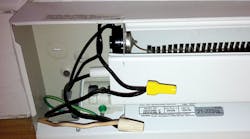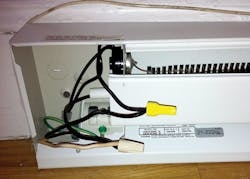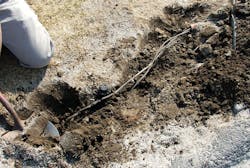How well do you know the Code? Think you can spot violations the original installer either ignored or couldn't identify? Here's your chance to moonlight as an electrical inspector and second-guess someone else's work from the safety of your living room or office. It's your turn to identify the violation.
Hint: A white hot heater
July Winner
Our only winner this month was Gilbert Dominguez, the owner of Century Electric in San Antonio. He correctly pointed out that the burial depth of this cable did not meet NEC requirements.
Direct buried cables (such as these UF cables) are required to be installed deep enough to meet the minimum cover requirements found in Sec. 300.5(A). According to the information found at the top of Column 1 in Table 300.5, UF cables installed in a grassy lawn location require a minimum cover depth of 24 in. As you can probably see in the photo, these UF cables are only buried about
2 in. deep. They’ve already been damaged at least once as indicated by the direct bury splice kit installed on the cable next to the lawn sprinkler head. A lesser depth of only
18 in. is permitted where UF cables are located in a trench below a 2-in. to 4-in.-thick concrete slab, or if located under driveways or parking areas at one-family or two-family dwellings or under airport runways.






